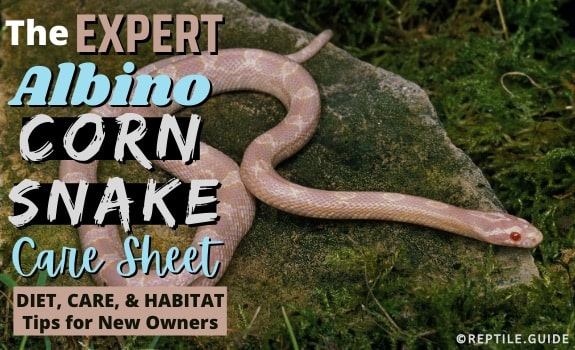The Albino Corn Snake is a pretty common pet… at least as far as reptiles go!
Their small size, inquisitive personality, attractive pattern, unique color, and easy care level are big draws to rookie and long-time snake keepers.
If you’ve ever gone to a store that regularly sells reptiles, you’ve probably seen one first-hand! That’s just how popular they are.
And if you’re curious about how you might take care of that “little snake in the window,”? Well, look no further!
We’re going to cover the basics that every new Albino Corn Snake owner should know to keep their pet happy and healthy!
In This Article
Species Summary
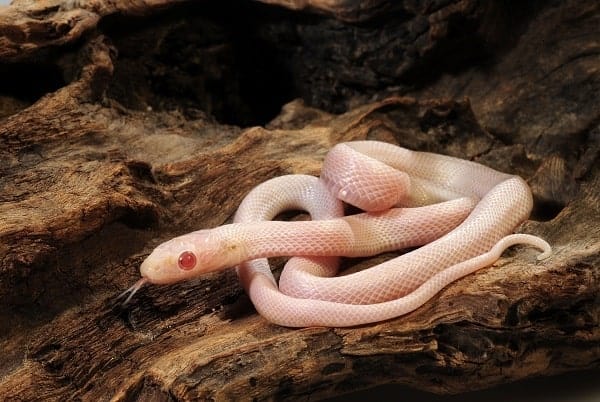
Corn Snakes (opens in new tab) are a small- to medium-sized species of colubrid snake native to the southeastern United States.
Colubrid snakes are non-venomous and incapacitate their prey by constricting it. They’re usually more active and more slender-bodied than their distant constrictor cousins, the boas and pythons.
Corn Snakes were named for their tendency to occupy corn fields and corn silos, where their preferred prey (rats and mice) are readily available.
This species is highly adaptable, inhabiting any environment that provides a steady source of rodents.
Corn Snakes can be found in the wetland swamps, woodlands, fields, and especially old, abandoned human dwellings. They’re considered semi-arboreal, especially as youngsters.
In colder climates, they enter a dormant period known as brumation during the Winter.
Corn Snakes breed during the Spring, usually after emerging from their Winering quarters.
According to the Oregon Zoo, the female then lays a clutch of 12-24 eggs around a month later, which incubate for about two and a half months.
The Albino Corn Snake is known as a color morph. It’s selectively bred for in captivity because of its attractive and unique appearance, and it’s one of the MOST common Corn Snake morphs available.
Other names for these snakes include Amelanistic Corn Snakes or Amel Corn Snakes.
Appearance & Colors
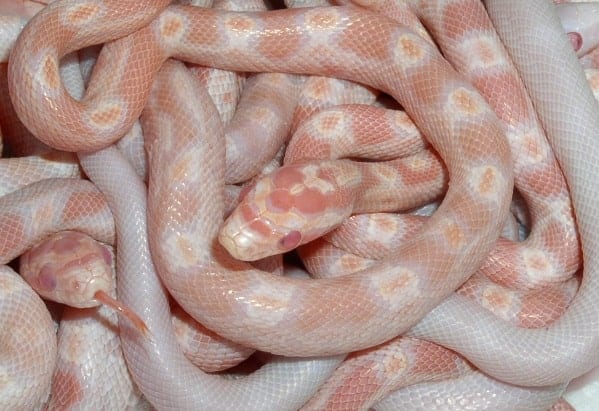
Albino Corn Snakes lack black pigment, also known as melanin. That’s why the scientific term for this morph is amelanistic.
In fact, speaking of scientific, scientists often study their unique color variant to learn more about gene mutation in snakes!
They usually feature the same saddle-like pattern and checkerboard belly as wild-type Corn Snakes, but without any black, gray, or brown.
Instead, these attractive snakes are striking shades of orange, yellow, red, and white.
Albinism may also be combined with other morphs to create entirely new looks. Additionally, the Albino color may also be combined with pattern morphs that change the saddles to stripes, ladders, and more.
⭐️ Fun Fact: An “Albino” and “Anerythristic” Corn Snake is known as “Snow,” and it’s completely white and off-white without any red or black hues. Meanwhile, an “Albino” and “Caramel” Corn Snake is known as a “Butter” Corn Snake, and they’re mostly yellow.
Albino Corn Snake Size
Albino Corn Snakes grow to the same size as wild-type Corn Snakes, usually around 3 to 6 feet long.
While they attain the same length as another popular pet snake, the ball python, it’s important to note that Corn Snakes have much more slender bodies.
While a 4-foot ball python may weigh 3 pounds, a 4-foot corn snake will only weigh 1 pound. Healthy adult Albino Corn Snakes are no thicker around than a half-dollar coin.
Hatchling Albino Corn Snakes are only 12 to 14 inches long and about as thick around as a pencil. They usually weigh a mere 6 to 8 grams! They look like colorful little worms.
Lifespan
Compared to many other common pet snakes, Albino Corn Snakes have a shorter lifespan of 15 to 20 years. Still, it’s not uncommon for them to live into their mid to late 20s if they’re well cared for.
That’s still a drastic improvement to the 6- to 8-year lifespan of their wild cousins!
Albino Corn Snake Care
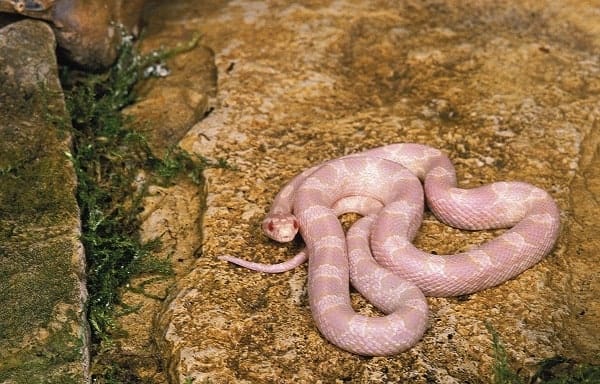
When it comes to husbandry, Albino Corn Snakes are among the LEAST demanding snakes you could bring home!
Reptile enthusiasts have been bringing this prevalent species home and caring for it for decades, so there’s plenty of knowledge and history to back up common Corn Snake husbandry standards.
Enclosure Size & Dimensions
Minimum Adult Enclosure Size: 36” x 18” x 16” or 40-Gallon Breeder Aquarium
Your Albino Corn Snake’s enclosure should be as long as the snake’s body. This means that a 36″ habitat would only work for individuals on the smaller side of “average.”
Huge Corn Snakes may even require a 125-gallon aquarium!
Hatchling and juvenile Albino Corn Snakes may be housed in smaller enclosures, as long as you provide them enough room to stretch out entirely as they grow.
Height is also an important factor when housing your Albino Corn Snake. These guys love to climb, especially as babies. We recommend a minimum of 12″ of cage height, preferably more.
The enclosure can be made from glass, acrylic, sealed wood, or PVC. Aquariums, terrariums, plastic storage tubs, and manufactured reptile enclosures all make excellent choices for housing your Albino Corn Snake.
However, each type of enclosure has its own benefits and drawbacks….
For example, glass aquariums are widely available and allow you to view your Albino Corn Snake from all angles, but they’re heavy and will break if they fall or are dropped.
Meanwhile, PVC reptile enclosures tend to be pricey, but they insulate heat and humidity well.
What enclosure you ultimately choose should always come down to what you feel will work best for you and your pet based on your own research.
Habitat Setup
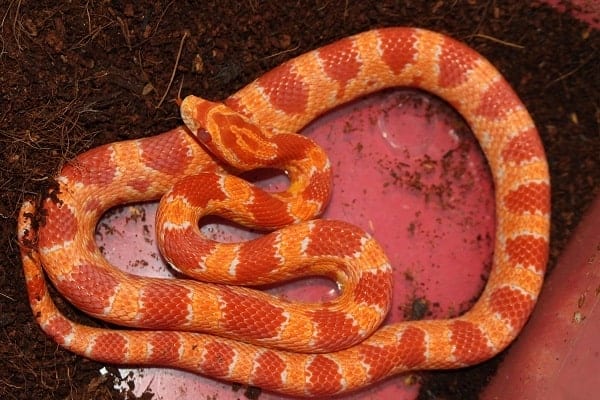
A basic Albino Corn Snake set-up includes substrate, at least two hides, and a water dish. But we encourage you to go above and beyond the bare-bones “basic” set-up!
Most Albino Corn Snakes LOVE burrowing. As such, we recommend a loose substrate that is malleable and easy to sift and maneuver under.
Ideal substrate options include:
- Aspen shavings
- Cypress mulch
- Naturalistic or bioactive soil mixture
- Coconut fiber
- Coconut husk
If you’re in a pinch with an unexpected new pet or setting up quarantine or treatment quarters, you may use something cheap and easy to clean. Paper towels, non-glossy newspaper, dye-free corrugated cardboard, and butcher block paper will work temporarily.
However, just be mindful of the fact that you’ll need to work harder to maintain optimal humidity levels with these cheaper options.
You can purchase naturalistic snake hiding decorations from most pet stores. The options are endless, ranging from rocky caves to hollow logs.
Feel free to get creative, too! Many reptile keepers create hides from small plastic containers with one or two entrance holes cut or melted out. Cardboard boxes and tubes also make excellent free disposable hides.
At a minimum, you’ll want one hide on the cool end of the enclosure and one hide directly above or under the heating element.
Reptiles have been known to make themselves too hot or too cold simply because only one hiding spot is available.
Albino Corn Snakes occasionally enjoy extra humidity, especially when they’re getting ready to shed. Try keeping a bed of damp sphagnum moss under one of their hides to offer an extra-humid retreat.
Wild Corn Snakes occasionally go for a dip in natural bodies of water. As such, you should aim to provide your Albino Corn Snake with a water dish that’s at least big enough for them to fit inside of and submerge their body.
A large water dish will also help you to maintain high humidity in the enclosure.
While those are the core necessities, we encourage you to offer more than two hides, plenty of climbing opportunities, and different textures to explore.
Rocks, driftwood, branches, bird ladders and ropes, cork bark, plants, and elevated hides all make excellent additions to any enclosure and stimulate your Albino Corn Snake’s senses and mind.
Temperature & Lighting
Ideal Basking Spot Temperature: 85-90°F
Ideal Warm Side Ambient Temperature: 78-85°F
Ideal Cool Side Ambient Temperature: 75-78°F
Optional Night-time Temperature Drop: 68-72°F
Albino Corn Snakes require supplemental heating, but they don’t need additional lighting.
A day and night cycle is important for your Corn Snake’s long-term wellbeing, but ambient lighting in the room and sunlight from windows may be adequate to stimulate this.
Turning the heating element off and allowing the enclosure to drop down to room temperature at night may also be helpful and beneficial.
Albino Corn Snakes may be more sensitive to light than wild-type animals, so be sure to offer loads of shaded areas and hides if you choose to light the habitat.
They’re also more prone to burns from UV lighting, so opt for a low-UVI lighting system if you go that route.
Despite the extra sensitivities and precautions, Albino Corn Snakes will benefit from some UVB exposure, although it’s not required.
Depending on how your Albino Corn Snake’s habitat is set up, you can heat it with a halogen light bulb, ceramic heat emitter, carbon filament heat projector, radiant heat panel, heating pad, heat tape, or heating cable.
Halogen light bulbs produce penetrating infra-red heat that mimics natural sunlight exposure. Always run heating elements on a thermostat to avoid starting a fire or burning your pet.
Humidity
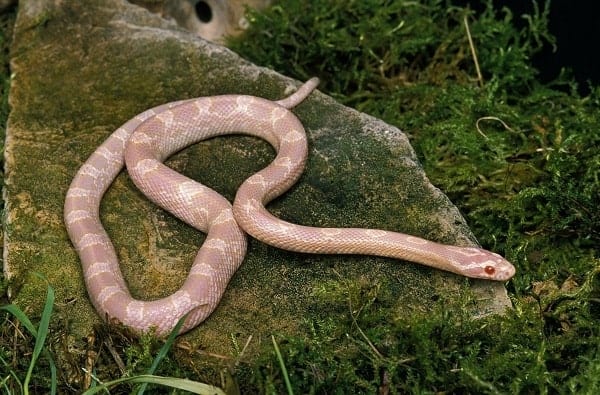
Ideal Humidity Level: 65-75%
Since the average humidity level in a household is 30-50%, you’ll need to put some effort into raising the humidity in your Albino Corn Snake’s habitat.
The easiest way to maintain ideal humidity is to use a substrate that holds onto moisture and releases it into the air gradually. Good examples of this include substrates such as coconut fiber, coconut husk, cypress mulch, or a soil mixture.
Meanwhile, aspen shavings, reptile carpet, and paper bedding do the EXACT opposite of what you want – they dry out the air.
Allow the substrate to dry out completely for a day or two to prevent mold growth, then add more water to raise the humidity level.
Mixing and fluffing up the substrate after your Albino Corn Snake has compacted it will also help release moisture into the air. You can also try spraying down or misting the enclosure as needed.
As outlined above in the set-up portion of our guide, a large water dish and a humid hide are also helpful tools for giving your Albino Corn Snake the humidity it needs.
Water
Provide your Albino Corn Snake with a water dish that’s large enough to soak in and, preferably, large enough to move around or “swim” in.
Snakes enjoy fresh water, so the best practice is to replace the water daily. At a minimum, you’ll want to replace the water every three days, or whenever it’s soiled with waste or bedding.
Lastly, you’ll need to wash the water dish with hot water and soap at least once a week.
Food & Diet
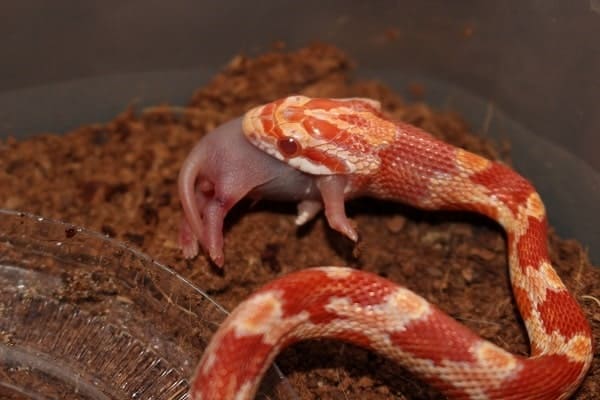
Corn Snakes are predators that prefer rodent prey. It’s best to feed your Albino Corn Snake a diet of pre-killed or frozen mice in captivity.
Warm them up to mammalian body temperature before offering them to your pet.
Baby Corn Snakes Feeding Schedule: Once every 5 to 7 days
Juvenile Corn Snakes Feeding Schedule: Once every 7 to 10 days until they’re 12 months old
Adult Corn Snakes Feeding Schedule: Once every 10 to 21 days.
The prey item should be as wide as the thickest part of your snake’s body OR large enough to leave a slight bulge in your snake that disappears within a day.
Potential Health Issues
If you notice your Albino Corn Snake exhibiting any of these symptoms, take it to your local reptile veterinarian as soon as possible:
- Long-term food refusal accompanied by drastic weight loss
- Frequent regurgitation
- Clicking, rattling, or wheezing while breathing
- Open-mouth breathing
- Discharge from mouth or nostrils
- Skin lesions or discolored scales
- Mucousy or bloody diarrhea
- Loss of coordination
Temperament & Handling
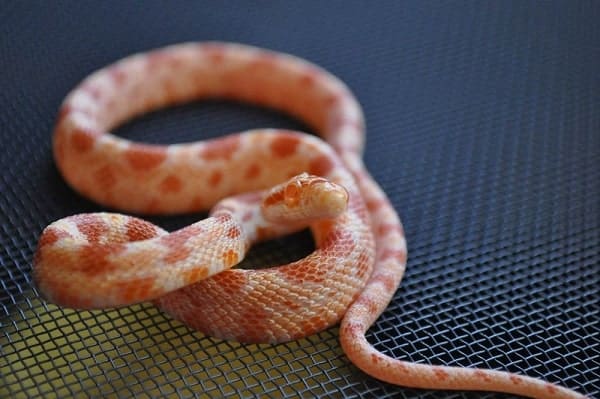
Corn Snakes are known for their calm and inquisitive demeanor. Being colubrids, they’re considerably more active and interactive than boas and pythons.
They’re considered crepuscular, meaning that they’re most active at dawn and dusk. This is when you’re most likely to see your Albino Corn Snake exploring its enclosure or “asking” to come out.
Hatchling Corn Snakes are tiny and afraid of the world, so they may be nippy at first. Give them time to grow and get used to you and their surroundings. The good news is that their teeth are so small that you likely won’t even feel their bite!
When handling your Albino Corn Snake, aim to support its body and “be a tree.”
Don’t try to grip, squeeze, or otherwise restrain your Corn Snake – allow it to move freely between your fingers, in a hand-under-hand motion.
Conclusion
Overall, Albino Corn Snakes are delightful and attractive snakes to own.
They’re hardy and capable of thriving in a wide variety of conditions, and their interactive and inquisitive personality is captivating.
Whether this is or will be your first snake or your tenth snake, we promise you’ll fall in love with the Albino Corn Snake. And by utilizing the information we’ve covered together, you can enjoy your new pet for many years to come!
Keen on more albino animals? Go for the albino African clawed frog!
